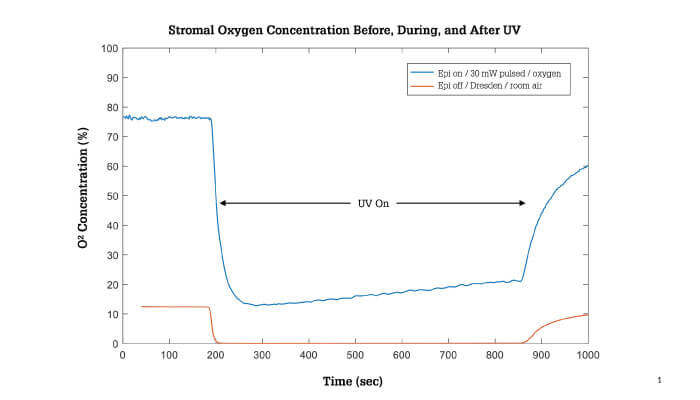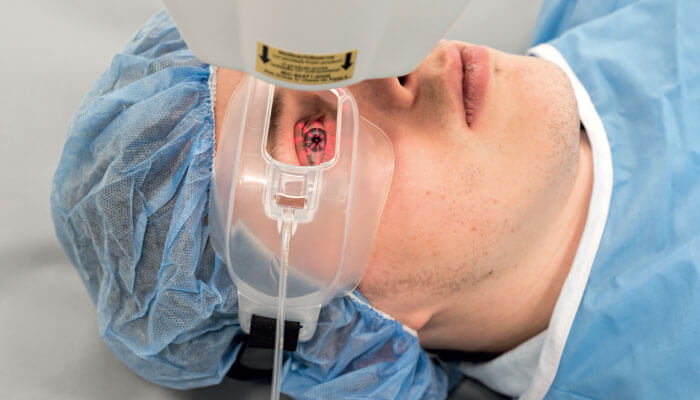
Epithelium-off (epi-off) CXL has been effective in halting the progression of keratoconus, offering hope to many patients with this progressive condition (1). Epithelium-on (epi-on) CXL, in which the epithelium is minimally disturbed, has historically not been as successful (2).
Various attempts have been made to modify established cross-linking protocols in order to make an epi-on version more effective. The complex biochemistry of CXL, in which riboflavin, ultraviolet (UV) light, and oxygen all play a role, forces us to confront several challenges. The intact epithelium blocks the transfer of riboflavin into the stroma and can absorb some of the UV light that must reach the stroma. Furthermore, the epithelium blocks atmospheric oxygen from reaching the stroma and biomechanically reduces the amount of available oxygen. The chemical reactions in CXL procedures — both epi-on and epi-off — also deplete atmospheric oxygen instantly, reducing stromal oxygen to very low levels. Pulsing, or cycling the UV light on and off to allow oxygen to replenish during the “off” cycles, is helpful, but has not been sufficient to restore oxygen to the desired levels (3).
In order to perform epi-on CXL successfully, we ideally want to optimize all of the factors that we can control, including the riboflavin formulation (riboflavin, vehicle and other components), the intensity and delivery mode of the UV irradiation, and the delivery of supplemental oxygen.
Exploring new strategies
One promising new strategy is to increase the ambient oxygen concentration on the cornea by delivering supplemental oxygen at the ocular surface throughout the CXL procedure. Recent laboratory research has demonstrated that this approach significantly increased the oxygen availability in the stroma of ex vivo porcine eyes treated with high-irradiance epi-on CXL compared to a pulsed protocol with no supplemental oxygen (4).
And, when researchers compared two epi-on protocols, again in an animal model, a greater degree of corneal collagen stiffening occurred in eyes receiving riboflavin with benzalkonium chloride (BAC), supplemental oxygen, and pulsed UV at 30 mW/cm2, with 1 sec:1 sec pulsing, and 10 J/cm2, compared to eyes that received riboflavin with sodium iodide, room air, and 4 mW/cm2, 15 sec:15 sec pulsing, and 4.1 J/cm2 UV (5).
Clinical trials
In my opinion, supplemental oxygen has the potential to improve both epi-on and epi-off CXL.
The scientific support for oxygen in cross-linking is currently being evaluated in Phase III clinical trials of epi-on CXL in the US, where I am a clinical investigator. In this prospective, randomized, controlled study of a drug-device combination product from Avedro, several variables have been modified from traditional epi-off protocols. We are applying riboflavin that has been modified to help enhance penetration through the epithelium into the stroma, delivering pulsed UV light at increased intensity, and providing supplemental oxygen using Boost goggles. The goggles are worn throughout the UV light application, to help increase the oxygen concentration on the corneal surface to >90 percent.
Another study with a similar protocol is being conducted at eight European and seven international sites, where investigators are using two different epi-on riboflavin formulations (0.25 riboflavin with benzalkonium chloride and 0.22 percent riboflavin) that have received the CE mark; supplemental oxygen delivered with the Boost goggles, and accelerated pulsed UV light at 30 mW/cm2.
We know that epi-off CXL treatment is effective and is considered the standard of care. Before offering epi-on procedures more broadly, it is important to evaluate the safety and efficacy of new techniques in well-controlled clinical trials in humans. The results may help us determine which cases will benefit from epi-off or epi-on procedures and help us develop better treatment algorithms.
Overall, cross-linking has been a wonderful advancement for our patients with keratoconus. There is still room for improvement, and I am enthusiastic about the potential for new protocols, that modify more of the variables we can control, in order to achieve the greatest efficacy possible. In addition to the oxygen innovations described here, future protocols may allow us to customize the application of UV light, providing even more effective treatments.

References
- PS Hersh et al., “United States Multicenter Clinical Trial of Corneal Collagen Crosslinking for Keratoconus Treatment”, Ophthalmology, 124, 1259 (2017). PMID: 28655538.
- H Kobashi et al., “Transepithelial versus epithelium-off corneal crosslinking for corneal ectasia”, J Cataract Refract Surg, 44, 1507 (2018). PMID: 30314751.
- L Sun et al., “Transepithelial accelerated corneal collagen cross-linking with higher oxygen availability for keratoconus: 1-year results”, Int Ophthalmol, 38, 2509 (2018). PMID: 29116549.
- J Hill et al., “Biomechanical impact of drug formulation, supplemental oxygen, and UV delivery on epi-on CXL”. Presentation at ARVO, April 27-May 2, 2019, Vancouver, Canada.
- J Hill et al., “Stromal oxygen dynamics during high-irradiance epi-on corneal crosslinking”. Presentation at ARVO, April 27-May 2, 2019, Vancouver, Canada.
